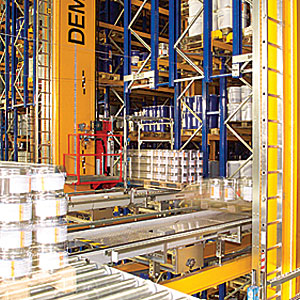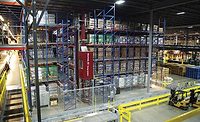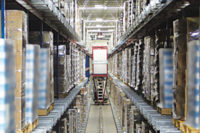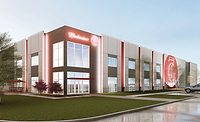Although SKU proliferation is nothing new to the beverage industry, the phenomenon still is causing many warehouses to explore different ways to accommodate these growing product lines.
|
Bill Leber, business development manager for warehouse and distribution solutions for Swisslog, Newport News, Va., notes that SKU proliferation has been around for a long time, but it has accelerated within the last few years.
“In 2009, we were working with a potential automation system for a beverage distributor [that] serviced convenience stores,” he explains. “… [The client] said, … ‘We’ll never have to deal with more than about 350 SKUs because there’s just so much that convenience stores can handle, and they’re not going to want anymore.’”
Leber re-visited this client approximately 18 months ago, and it then was accommodating 700 SKUs. “I said, ‘Hey, it was only a couple of years ago [that] you told me you’d never get over 350 or 400,’” Leber says. “He said, ‘I just can’t believe it. I’ve been in this business for 30 years, and I just never could believe the way things have exploded with all the variety in the last few years.’”
With these additional SKUs come challenges with storage and efficient picking operations. “SKU proliferation creates more pressure on warehouse operations to have these products available to pick and do so productively,” says Dan Labell, president of Westfalia Technologies Inc., York, Pa. “It may create systems and processes whereby lower-volume SKUs are handled and stored differently than higher-volume SKUs, sometimes in completely different areas.”
Labell adds that storage systems are designed to accommodate the growth of SKUs, and if they are not fulfilling that purpose, there could be issues with the design. “Continued centralization of distribution operations actually pool more volume into single locations and thus make storing and picking these SKUs more productive,” he says. “This drives costs down due to purchase volume increases as well.”
According to consulting building design firm Haskell, simply adding a new package size or flavor can greatly impact a warehouse. “This will drive higher storage and pick-facing locations as well as impact shipping volumes (order fulfillment),” the Jacksonville, Fla.-based company says. “With this, managing facings has become a real issue because it impacts layout and warehouse capacity. Increased volumes of orders and variations of order profiles impact order management systems.
“Production scheduling concerns influence capacity and customer service levels may be reduced,” it continues. “Increased automation, such as [material requirements planning] (MRP) systems and variants to manage capacity and tracking become crucial.”
Autopilot
One of the ways distribution centers can address these storage challenges is through various forms of automation, experts note.
“We are beginning to see automated case handling solutions in the beverage market that create ‘SKU independent’ staging or buffering systems,” says Sean O’Farrell, market development director at Dematic North America, Grand Rapids, Mich.
Dean Hoerlein, vice president of warehousing for Verst Group Logistics, a third-party logistics company based in Walton, Ky., notes that operations seem to be gravitating toward automation more and more.
However, Westfalia’s Labell explains that levels of automation and selection of those systems vary and are dependent on each warehouse’s individual situations and potential growth scenarios.
“These should be modeled to determine the best path forward, i.e., selection of levels of automation, whether to go build high versus building out, etc.,” he says.
Swisslog’s Leber notes that automation also comes into play as distributors look to address the cost pressure associated with SKU proliferation.
“There’s a lot of pressure on all of these warehouses and distribution centers to cope with SKU proliferation and not incur higher costs, so they’re asked to take their infrastructure that they’ve had in place and now they have to get more out of it, and that’s where automation can help,” he says.
Leber explains that automation can improve an existing area through streamlined efficiencies. For example, Swisslog recently partnered with Power Automation Systems and its Power Store System, a cart-based automated storage and retrieval system (AS/RS). Leber notes that this system is more focused on higher throughput from existing and smaller warehouses.
“That’s why we think it’s going to be a very good product line in the future, because people don’t want to invest in a brand-new warehouse,” he says. “The real focus is, ‘How can we get more out of our existing assets?’”
Greenville, S.C.-based Hartness International, a division of ITW Warehouse Automation, also offers a cart-based AS/RS through its StorFast system. Cart-based systems can provide a higher throughput than traditional crane-based systems, it says.
However, this has not always been the case for the beverage industry. Leber says that automation systems in the beverage industry are not as commonly utilized in the United States compared with Europe. However, the landscape is changing as more warehouses are implementing them.
What fits your needs
As warehouses turn to technology to solve some of their storage challenges, companies have a plethora of options from which to choose.
“There are new technologies available to address the movement of higher quantities of SKUs and more varied order profiles,” a Haskell spokesperson says.
At Dematic, its Multishuttle system is designed to handle two different options: goods-to-person or person-to-goods, O’Farrell says. In goods-to-person, the case is delivered to the pick operator, while the hybrid person-to-goods features a carton flow rack out of the side of the system.
“This creates enough flexibility for a company to buffer a shift’s worth of cases in a highly dense, high-throughput, floor-to-ceiling automated storage and retrieval system,” O’Farrell says.
Haskell’s spokesperson notes that when investing in a storage system, warehouses should consider a number of factors including flexibility, limited stacking strength and expandability. “More specifically, SKU quantities, projected growth rates, order profiles and future order fulfillment objectives should be considered and evaluated,” the company says. “Often a phased approach can be implemented to contain initial investments. Horizon for return on investment can be used to drive how many growth years are measured. They should also introduce [warehouse management software] systems and proliferation management options early in their decision-making process.”
Third-party logistics addressing SKU proliferation
For beverage distributors, the growth of SKUs has challenged the storage space in their warehouses. However, these operators are not the only ones facing this challenge. Third-party logistics firms also are finding ways to ensure that their warehouses still are meeting their customers’ needs.
“It’s pretty much a constant battle,” says Dean Hoerlein, vice president of warehousing for Walton, Ky.-based Verst Group Logistics. “What that has done from our side is it creates a scenario where we have a lot more pick facings, so our overall storage density that we can have in the building isn’t as great.”
Hoerlein notes that because Verst tradi-tionally is not on-site during manufacturing processes for its customers, if there are changes in production, they do not know. Because of this, flexibility is crucial for their operations.
“From our standpoint, we have to be very flexible with our storage system and how we allocate space for that, so we drive that a lot through our [warehouse management system] (WMS) to help us recognize when things should be in for pick locations, when they should go back into reserve locations for bigger bulk storage needs, when things need to go up into the rack, or when they need to stay on the floor for picking,” he says. “We’re constantly analyzing those things — sometimes weekly, sometimes quarterly — for warehouse reset, so those multiple SKUs and batches are being evaluated typically with our customer at least once a quarter and internally in our warehouse probably once a week.”






